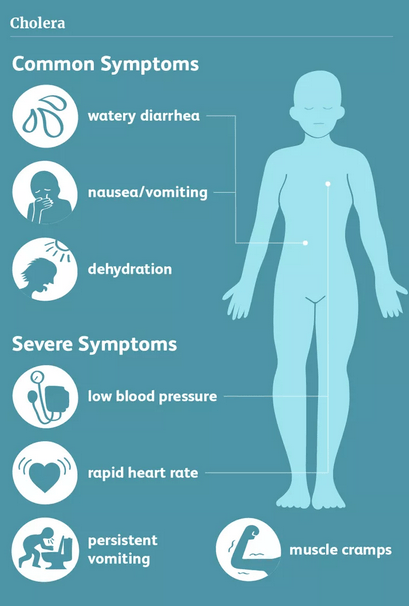Cholera is a disease that has plagued humanity for centuries, causing severe outbreaks and untold suffering. Understanding its causes, prevention, and treatment is vital in our ongoing battle against this ancient scourge. In this comprehensive article, we will delve into the intricacies of cholera, exploring its contagious nature, its status as a bacterial disease, its symptoms, and effective means of prevention and treatment. We will also address some common misconceptions about cholera, including its relation to typhoid, dysentery, and cystic fibrosis.
Cholera Symptoms:
Cholera symptoms include watery diarrhea, vomiting, dehydration, muscle cramps, rapid heart rate, and shock. It can lead to severe fluid loss and, in severe cases, can be life-threatening.
Cholera Treatment:
Cholera is treated through rehydration using oral rehydration solutions (ORS) or intravenous fluids (IV) in severe cases. Antibiotics may also be used in some cases to shorten the duration and severity of the illness.
Cholera Prevention:
Preventing cholera involves ensuring access to clean drinking water, proper sanitation practices, good personal hygiene, and, in some cases, vaccination. Avoiding contaminated food and water sources is also crucial.
Cholera is caused by:
Cholera is caused by the bacterium Vibrio cholerae.
How is Cholera Transmitted:
Cholera is primarily transmitted through the consumption of water or food contaminated with Vibrio cholerae bacteria. Contaminated water and poor sanitation are common routes of transmission.
Is Cholera Contagious:
Yes, cholera is contagious. It can be spread from person to person, especially in crowded or unsanitary conditions, but the main mode of transmission is through contaminated water and food.
Cholera Disease:
Cholera is an acute diarrheal disease that can lead to severe dehydration and, if not treated promptly, can be life-threatening. It has been a major public health concern in areas with poor sanitation and limited access to clean water.
Cholera Symptoms and Diagnosis
Identifying the Onset of Cholera:
Recognizing the early symptoms of cholera is crucial for timely intervention. We’ll outline the common signs and symptoms of cholera infection.
Diagnostic Methods:
From stool tests to culture methods, several diagnostic tools are available to confirm cholera. We’ll explain these methods and their reliability.
Cholera:
The Basics
Cholera is a devastating disease caused by the bacterium Vibrio cholerae. It primarily spreads through the ingestion of contaminated water or food, with symptoms ranging from mild to severe, including profuse, watery diarrhea and dehydration. The bacterium, once ingested, releases a potent toxin that causes the excessive release of fluids into the intestines.
Cholera Contagion:
Is It a Concern?
Cholera is primarily transmitted through the fecal-oral route, which means that it’s not highly contagious from person to person. However, it can spread within communities due to poor sanitation and the contamination of water sources. Understanding this mode of transmission is crucial to curbing cholera outbreaks and implementing effective prevention measures.
The Misconception:
Is Cholera a Virus?
Cholera is often mistaken for a viral disease, but it is, in fact, caused by the bacterium Vibrio cholerae. The confusion may arise from the fact that both viruses and bacteria can cause gastrointestinal illnesses, but understanding the distinction is important for appropriate prevention and treatment.
Cholera:
A Communicable Disease
Yes, cholera is a communicable disease, but the level of contagiousness from person to person is relatively low. Contaminated water and food sources are the primary vehicles of transmission, and maintaining proper hygiene and sanitation is crucial to preventing its spread.
Cholera, Typhoid, and Dysentery:
Cholera and Typhoid:
It is often mentioned alongside typhoid due to their shared risk factors and symptoms. We’ll explore the differences and similarities between these two diseases.
Cholera vs. Dysentery:
Both cholera and dysentery cause severe gastrointestinal distress, but they are distinct diseases. We’ll compare their causes, symptoms, and treatments.
Cholera and Cystic Fibrosis:
An unexpected link exists between cholera and cystic fibrosis, a genetic disorder. We’ll discuss this connection and its implications.
Distinguishing the Trio
Different pathogens cause distinct diseases such as cholera, typhoid, and dysentery. Vibrio cholerae causes cholera, Salmonella typhi causes typhoid fever, and various bacteria, including Shigella and enteroinvasive E. coli, can cause dysentery. Each disease has its unique set of symptoms, modes of transmission, and treatment approaches.
Cholera and Cystic Fibrosis:
Unrelated Ailments
Cystic fibrosis is a genetic disorder that primarily affects the respiratory and digestive systems. Cholera and cystic fibrosis are unrelated conditions with different causes and manifestations.
Prevention and Hygiene:
The Cornerstones of Cholera Prevention
Effective prevention of cholera involves ensuring access to clean and safe drinking water, practicing good hygiene and sanitation, and vaccination in high-risk areas. Proper handwashing, avoiding the consumption of raw or undercooked seafood, and maintaining good sanitation practices can greatly reduce the risk of cholera transmission.
Cholera Vibrio:
The Culprit Behind the Disease
Vibrio cholerae is the specific bacterium responsible for causing cholera. Understanding its characteristics and the mechanisms of infection can help in devising effective prevention and treatment strategies.
Understanding Vibrio cholerae:
In this section, we’ll dive deeper into the bacterium Vibrio cholerae, its unique characteristics, and its relationship with the disease.
Its Impact on Cholera:
What role does Vibrio cholerae play in the pathogenesis of cholera? We’ll explore how the bacterium affects the human body and triggers the disease.
Cholera:
A Disease of Significance
Cholera continues to be a significant global health concern, especially in areas with inadequate sanitation and limited access to clean water. The disease can lead to severe outbreaks with devastating consequences.
Cholera Outbreaks:
Preventing and Managing
Cholera outbreaks can occur when contaminated water and food sources lead to multiple cases of the disease in a community or region. Swift public health measures, including vaccination campaigns and improved sanitation, are vital in controlling and preventing outbreaks.
Past and Present
Notable Cholera Epidemics: Throughout history, cholera has caused significant pandemics. We’ll examine some of the most devastating outbreaks and their consequences.
Modern-Day Cholera Outbreaks:
Despite progress, cholera outbreaks still occur. We’ll look at recent outbreaks, their causes, and the efforts to contain them.
In this comprehensive article, we aim to provide a thorough understanding of cholera, its prevention, contagiousness, and treatment. By exploring the historical context, scientific aspects, and practical measures to combat cholera, readers will gain valuable insights into this persistent global health challenge.
Cholera Treatment:
Rehydration and Antibiotics
The treatment of cholera primarily involves rehydration using oral rehydration solutions (ORS) or intravenous fluids in severe cases. Antibiotics may also be used in specific situations. Early and appropriate treatment is critical to prevent complications and fatalities.
Rehydration Therapy:
Oral rehydration therapy (ORT) is a cornerstone of cholera treatment. We’ll discuss the importance of rehydration and its different methods.
Antibiotics and their Role:
In more severe cases, antibiotics may be necessary. We’ll cover the antibiotics used to treat cholera and their effectiveness.
Supportive Care:
Cholera can lead to severe dehydration and electrolyte imbalances. We’ll delve into the supportive care measures that help patients recover.
Cholera Vaccine:
A Preventive Measure
Cholera vaccines, including oral cholera vaccines, are available and can provide a level of protection against the disease. They are recommended for travelers to high-risk areas and in outbreak response efforts.
Types of Cholera Vaccines:
Cholera vaccines are essential for preventing outbreaks. We’ll explore the different types of cholera vaccines and their efficacy.
Who Should Get Vaccinated?
Vaccination strategies vary depending on the risk factors and geographic location. We’ll discuss the target populations for cholera vaccination.
Preventing and Managing
Cholera outbreaks can occur when contaminated water and food sources lead to multiple cases of the disease in a community or region. Swift public health measures, including vaccination campaigns and improved sanitation, are vital in controlling and preventing outbreaks.
Conclusion
Cholera remains a formidable health challenge, but with the knowledge and resources available today, we have the means to prevent and treat this disease effectively. Understanding its bacterial nature, its modes of transmission, and the importance of hygiene and vaccination are crucial steps in the ongoing battle against cholera. By addressing misconceptions and taking appropriate measures, we can reduce the burden of this ancient scourge and safeguard public health worldwide.
Faqs:
-
What is cholera and its symptoms?
Cholera is an acute diarrheal disease caused by the bacterium Vibrio cholerae. Symptoms include watery diarrhea, vomiting, dehydration, muscle cramps, rapid heart rate, and shock.
-
What is the first aid treatment for cholera?
First aid treatment for cholera involves rehydration using oral rehydration solutions (ORS) or intravenous fluids (IV) in severe cases. Antibiotics and zinc supplementation may also be used.
-
What are the five causes of cholera?
The main causes of cholera include contaminated water sources, contaminated food, poor sanitation, lack of personal hygiene, and overcrowding.
-
What are the 3 stages of cholera?
The three stages of cholera are:
- The incubation stage
- The acute stage
- The recovery stage
Read more: https://ysblogger.com/category/all-about-health/
YSBlogger.com provides well-researched and expertly written articles. The platform strives to empower its readers with the knowledge they need to prioritize their health and well-being. From articles about mental health and wellness to guides on effective workout routines and dietary advice.

